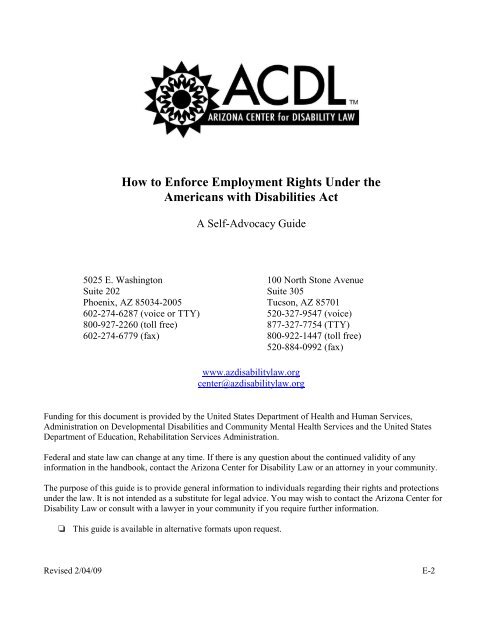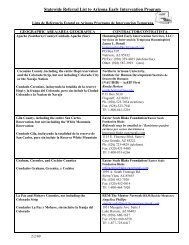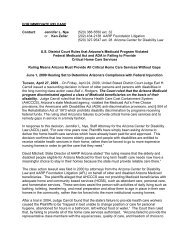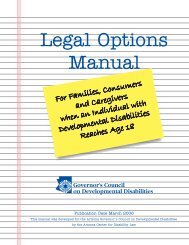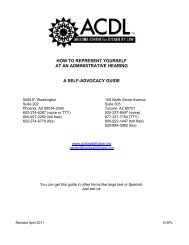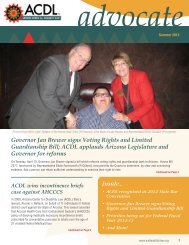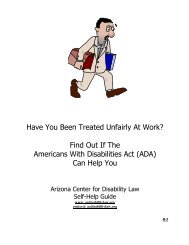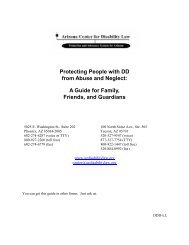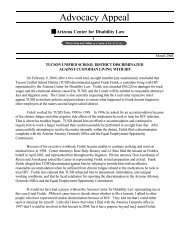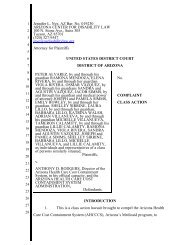How to Enforce Employment Rights Under the Americans with ...
How to Enforce Employment Rights Under the Americans with ...
How to Enforce Employment Rights Under the Americans with ...
Create successful ePaper yourself
Turn your PDF publications into a flip-book with our unique Google optimized e-Paper software.
<strong>How</strong> <strong>to</strong> <strong>Enforce</strong> <strong>Employment</strong> <strong>Rights</strong> <strong>Under</strong> <strong>the</strong><strong>Americans</strong> <strong>with</strong> Disabilities ActA Self-Advocacy Guide5025 E. Washing<strong>to</strong>nSuite 202Phoenix, AZ 85034-2005602-274-6287 (voice or TTY)800-927-2260 (<strong>to</strong>ll free)602-274-6779 (fax)100 North S<strong>to</strong>ne AvenueSuite 305Tucson, AZ 85701520-327-9547 (voice)877-327-7754 (TTY)800-922-1447 (<strong>to</strong>ll free)520-884-0992 (fax)www.azdisabilitylaw.orgcenter@azdisabilitylaw.orgFunding for this document is provided by <strong>the</strong> United States Department of Health and Human Services,Administration on Developmental Disabilities and Community Mental Health Services and <strong>the</strong> United StatesDepartment of Education, Rehabilitation Services Administration.Federal and state law can change at any time. If <strong>the</strong>re is any question about <strong>the</strong> continued validity of anyinformation in <strong>the</strong> handbook, contact <strong>the</strong> Arizona Center for Disability Law or an at<strong>to</strong>rney in your community.The purpose of this guide is <strong>to</strong> provide general information <strong>to</strong> individuals regarding <strong>the</strong>ir rights and protectionsunder <strong>the</strong> law. It is not intended as a substitute for legal advice. You may wish <strong>to</strong> contact <strong>the</strong> Arizona Center forDisability Law or consult <strong>with</strong> a lawyer in your community if you require fur<strong>the</strong>r information. This guide is available in alternative formats upon request.Revised 2/04/09 E-2
4. Information Request 165. Witness Interviews 176. Additional Evidence 177. Dismissal of Charge 178. Preliminary Findings 17F. Agency Decision 181. Discrimination Finding 182. Insufficient Evidence of Discrimination 183. Conciliation 184. Review of <strong>the</strong> Findings 185. Litigation 186. Reconsideration 19G. Remedies 19H. Strategies for <strong>the</strong> EEOC/ACRD Process 211. Negotiating <strong>with</strong> <strong>the</strong> Employer 212. Filing a Charge 213. Accommodations in <strong>the</strong> Charge Process 224. Contacts <strong>with</strong> Agency 225. Acceptance of Charge 226. Information for <strong>the</strong> Investiga<strong>to</strong>r 23a. Witnesses 23b. Documents 247. Mediation or Alternative Dispute Resolution 24a. Advantages/disadvantages 24b. At<strong>to</strong>rneys at Mediation 24c. Legal Advice Before Signing an Agreement 248. Requesting a Right <strong>to</strong> Sue Letter 259. Review of <strong>the</strong> Findings 2510. Requesting Reconsideration 25Appendix 26Discrimination by Recipients of Federal Financial Assistance 26Sample EEOC Intake Questionnaire 27ii
Sample Charge Form (ACRD/EEOC) 35Sample Notice of Right <strong>to</strong> Sue Letters (ACRD/EEOC) 37Sample Chronology 41iii
A. Introduction <strong>to</strong> The <strong>Americans</strong> With Disabilities Act (ADA) And ThisGuide1. OverviewOftentimes, people <strong>with</strong> disabilities do not have an equal opportunity <strong>to</strong> work or advance in<strong>the</strong>ir employment. People <strong>with</strong> disabilities are often restricted in employment opportunities bymany different kinds of barriers. Some face physical obstacles that ei<strong>the</strong>r make it difficult orimpossible <strong>to</strong> get in<strong>to</strong> and around a workplace or <strong>to</strong> use equipment. Some are excluded because<strong>the</strong>y communicate differently than <strong>the</strong>ir co-workers. Still o<strong>the</strong>rs are excluded because of rigidwork schedules that do not permit flexibility for people <strong>with</strong> special needs because of a disability.In o<strong>the</strong>r cases, people are denied opportunities, not because of actual barriers, but becauseof prejudice. These are <strong>the</strong> barriers in o<strong>the</strong>r people's minds: fears, stereotypes, presumptions, andmisconceptions about job performance, safety, absenteeism, costs, or lack of acceptance by coworkersand cus<strong>to</strong>mers.On July 26, 1990, Congress passed <strong>the</strong> <strong>Americans</strong> <strong>with</strong> Disabilities Act (ADA), whichprovides major civil rights protections <strong>to</strong> individuals <strong>with</strong> disabilities. The intent of this federallaw is <strong>to</strong> reduce barriers <strong>to</strong> people <strong>with</strong> disabilities and provide equal opportunities in employment,public accommodations, public services, transportation, and telecommunications. The varioustitles of <strong>the</strong> ADA affect many aspects of <strong>the</strong> lives of people <strong>with</strong> disabilities. Title I makes it unlawful <strong>to</strong> discriminate in employment against qualified people<strong>with</strong> disabilities. Title II makes it unlawful for state and local governments and <strong>the</strong>ir agencies <strong>to</strong>discriminate on <strong>the</strong> basis of disability in programs and services, including publictransportation. Title III prohibits discrimination on <strong>the</strong> basis of disability in access and enjoymen<strong>to</strong>f public accommodations and commercial facilities, such as hotels, motels,restaurants, professional offices, convention centers, s<strong>to</strong>res, banks, museums, parks,schools, and recreational facilities. Title IV requires accessibility of telecommunication services <strong>to</strong> hearing impairedpersons and o<strong>the</strong>r individuals <strong>with</strong> disabilities.1
There are limits <strong>to</strong> <strong>the</strong> types of lawsuits an individual can file under <strong>the</strong> ADA. Forexample, <strong>the</strong> U.S. Supreme Court has ruled that private individuals may not sue state employersfor money damages under <strong>the</strong> ADA. Individuals may still file charges of discrimination <strong>with</strong> <strong>the</strong>Equal <strong>Employment</strong> Opportunity Commission (EEOC) against <strong>the</strong>ir state employer for o<strong>the</strong>r relief,such as court orders <strong>to</strong> s<strong>to</strong>p discrimination. The U.S. Government can still file lawsuits againststates for violating <strong>the</strong> ADA.2. <strong>How</strong> <strong>the</strong> Arizona Center for Disability Law Assists People <strong>with</strong>DisabilitiesIf you believe you have been discriminated against on <strong>the</strong> basis of a disability inemployment or access <strong>to</strong> public services, public accommodations, public transportation, ortelecommunication services, staff at <strong>the</strong> Arizona Center for Disability Law (ACDL) can provideyou <strong>with</strong> information about <strong>the</strong> ADA and enforcing your rights. The ACDL is a non-profit, publicinterest law firm providing free advocacy, information and referral services, legal research,community legal education, and, in selected cases, legal representation <strong>to</strong> individuals <strong>with</strong>disabilities. The ACDL is <strong>the</strong> designated protection and advocacy system for Arizonans <strong>with</strong> awide range of physical and mental disabilities. Assistance is provided for disability-related issuesin established priority areas.Information about <strong>the</strong> eligibility requirements and priorities is available from <strong>the</strong> ACDL onrequest. Assistance is provided according <strong>to</strong> program eligibility requirements, priorities, and staffavailability. This guide will provide <strong>the</strong> reader <strong>with</strong> information about how <strong>to</strong> file a charge ofdiscrimination and remedies available for violations of <strong>the</strong> employment provisions of <strong>the</strong> ADA.O<strong>the</strong>r guides available through <strong>the</strong> ACDL on employment include:An Overview of <strong>the</strong> <strong>Employment</strong> Protections of <strong>the</strong> ADAThe ADA and <strong>the</strong> Job Applicant: Recruitment, Applications, and InterviewsThe ADA and Reasonable AccommodationsDrug and Alcohol Testing under <strong>the</strong> <strong>Americans</strong> <strong>with</strong> Disabilities Act (ADA)The ADA and Medical ExaminationsThe ADA and Confidentiality of Medical RecordsThe ADA and Disability-Related HarassmentThese guides are not substitutes for legal advice, but are meant <strong>to</strong> provide people <strong>with</strong>2
disabilities <strong>with</strong> information and examples about <strong>the</strong> employment protections under <strong>the</strong> ADA. TheACDL recommends that persons obtain professional legal advice <strong>to</strong> resolve a legal disputeregarding discrimination on <strong>the</strong> basis of a disability.3. When <strong>the</strong> <strong>Employment</strong> Protections of <strong>the</strong> ADA ApplyThe ADA does not cover every employment situation between an applicant or employee andan employer. For <strong>the</strong> ADA <strong>to</strong> apply <strong>to</strong> an employment situation, each of <strong>the</strong> following has <strong>to</strong> betrue:$ <strong>the</strong> employer is a covered employer;$ <strong>the</strong> employee or applicant has a disability according <strong>to</strong> <strong>the</strong> ADA;$ <strong>the</strong> employee or applicant is qualified <strong>to</strong> perform <strong>the</strong> job; and$ <strong>the</strong> employer discriminates against an applicant or employee on <strong>the</strong> basis ofdisability.The terms "covered employer" and "disability" are discussed below.a. Employers Covered By <strong>the</strong> <strong>Employment</strong> Protections of <strong>the</strong> ADAThe ADA applies <strong>to</strong> private employers <strong>with</strong> 15 or more employees and includes$ employment agencies and labor unions.$ a location or facility of a business <strong>with</strong> fewer than 15 employees whose <strong>to</strong>talnumber of employees for <strong>the</strong> company in all locations and facilitiescombined equals 15 or more.O<strong>the</strong>r state and local laws may apply <strong>to</strong> persons <strong>with</strong> disabilities who are employed by smallerbusinesses. For more information, contact <strong>the</strong> ACDL or a private at<strong>to</strong>rney.The ADA applies <strong>to</strong> state and local governments and includes:$ agencies, departments, and entities regardless of <strong>the</strong>ir size or number ofemployees, such as public schools, universities, libraries, museums, parks,and recreation facilities; police and fire departments; and social welfareoffices$ states, although employees (and applicants) cannot sue state employers incourt for money damages. Individuals can still file charges of3
discrimination <strong>with</strong> <strong>the</strong> EEOC against <strong>the</strong>ir state employer. Individuals canalso still sue <strong>to</strong> require state employers <strong>to</strong> take action or <strong>to</strong> s<strong>to</strong>pdiscrimina<strong>to</strong>ry action. The U.S. government can still file lawsuits againststate employers under <strong>the</strong> ADA. In addition, individuals can sue localgovernmental agencies, such as cities and counties, for money damages.The ADA does NOT apply <strong>to</strong> <strong>the</strong> federal government, but it does apply <strong>to</strong> employees of <strong>the</strong>U.S. Senate. <strong>How</strong>ever, generally if a person <strong>with</strong> a disability works or applies for a job <strong>with</strong> <strong>the</strong>federal government, a federal agency, or a fully owned U.S. governmental corporation, <strong>the</strong>re stillmight be protection. The Rehabilitation Act of 1973—ano<strong>the</strong>r anti-discrimination law that offersemployment protections for people <strong>with</strong> disabilities—might apply <strong>to</strong> jobs <strong>with</strong> <strong>the</strong> federalgovernment, a federal agency, or a fully owned U.S. governmental corporation. For example,employees and applicants of <strong>the</strong> U.S. Department of Labor and civilian employees of <strong>the</strong> U.S.Department of Army are covered by <strong>the</strong> Rehabilitation Act. For more information about <strong>the</strong>Rehabilitation Act, contact <strong>the</strong> ACDL, an Equal <strong>Employment</strong> Opportunity Counselor for <strong>the</strong>federal agency, or a private at<strong>to</strong>rney.Title I (<strong>Employment</strong>) of <strong>the</strong> ADA does NOT apply <strong>to</strong> Indian Tribes. <strong>How</strong>ever, tribes mayhave <strong>the</strong>ir own affirmative action or anti-discrimination laws that address discrimination on <strong>the</strong>basis of disability. Some tribes have adopted laws or entered in<strong>to</strong> agreements <strong>to</strong> abide by federaldiscrimination laws similar <strong>to</strong> <strong>the</strong> ADA. Contact a tribal legal office for more information about<strong>the</strong> tribal laws or agreements that may apply.b. Applicants or Employees With a DisabilityThe ADA protects qualified individuals <strong>with</strong> a disability. Disability is defined under <strong>the</strong>ADA as:(1) a physical or mental impairment that substantially limits an individual in <strong>the</strong>ability <strong>to</strong> perform major life activities, such as:4
$ seeing $ hearing $ walking$ working $ learning $ thinking$ reading $ lifting $ concentrating$ reproducing $ interacting <strong>with</strong> $ sleepingo<strong>the</strong>rs$ performing manual tasks in certain situations$ engaging in sexual relations(2) a his<strong>to</strong>ry of a substantially limiting impairment, or(3) being regarded as having a substantially limiting impairment.<strong>How</strong>ever, persons who are currently illegally using drugs are generally not considereddisabled because of <strong>the</strong>ir drug use. A person is qualified under <strong>the</strong> ADA if s/he has all of <strong>the</strong>skills, education, and experience required for <strong>the</strong> position and is able <strong>to</strong> perform <strong>the</strong> essentialfunctions of <strong>the</strong> job <strong>with</strong> or <strong>with</strong>out reasonable accommodations. For more information aboutwhat <strong>the</strong>se special terms mean, see <strong>the</strong> Center's guide, An Overview of <strong>the</strong> <strong>Employment</strong> Protectionsof <strong>the</strong> ADA.B. The Equal <strong>Employment</strong> Opportunity Commission1. Introduction <strong>to</strong> <strong>the</strong> EEOCThe EEOC is a federal agency <strong>with</strong> <strong>the</strong> responsibility <strong>to</strong> enforce <strong>the</strong> employment provisionsof <strong>the</strong> ADA (Title I). 1 This responsibility includes taking charges (or complaints ofdiscrimination) from people who believe that <strong>the</strong>y have been discriminated against in employmen<strong>to</strong>n <strong>the</strong> basis of a disability, investigating those complaints, making a determination of whe<strong>the</strong>r<strong>the</strong>re is reasonable cause <strong>to</strong> believe that discrimination occurred, and issuing Notices of Right <strong>to</strong>Sue (also called “right <strong>to</strong> sue” letters).The EEOC will also attempt <strong>to</strong> work out an agreement - sometimes called a "settlement" -between <strong>the</strong> parties <strong>to</strong> resolve <strong>the</strong> claim of discrimination if that is possible. Once a finding of1 The ADA prohibits discrimination in areas o<strong>the</strong>r than employment. For example, discrimination inpublic accommodations such as restaurants and movie <strong>the</strong>aters is prohibited. O<strong>the</strong>r agencies are charged<strong>with</strong> enforcing <strong>the</strong> non-employment provisions of <strong>the</strong> ADA. For example, <strong>the</strong> Department of Justiceinvestigates complaints of discrimination in public accommodations. For more information aboutcomplaint procedures for violations of o<strong>the</strong>r provisions of <strong>the</strong> ADA, contact <strong>the</strong> staff at <strong>the</strong> ACDL.5
discrimination has been issued, <strong>the</strong> settlement is called a “conciliation” agreement. The EEOCwill bring lawsuits against employers in selected cases for violations of <strong>the</strong> employment provisionsof <strong>the</strong> ADA. <strong>How</strong>ever, in most cases, <strong>the</strong> EEOC will only issue a "right <strong>to</strong> sue" letter that allows<strong>the</strong> individual <strong>to</strong> bring a private lawsuit under Title I of <strong>the</strong> ADA <strong>to</strong> enforce his/her own rights.Arizona also has <strong>the</strong> Arizona Civil <strong>Rights</strong> Act (ACRA), a state law that prohibitsdiscrimination in employment on <strong>the</strong> basis of a physical or mental disability. The Arizona Civil<strong>Rights</strong> Division (ACRD)—<strong>the</strong> state equivalent of <strong>the</strong> EEOC—enforces <strong>the</strong> ACRA.2. O<strong>the</strong>r Anti-Discrimination LawsThe EEOC enforces o<strong>the</strong>r laws that prohibit discrimination in employment, such as TitleVII of <strong>the</strong> Civil <strong>Rights</strong> Act of 1964 (Title VII). Title VII prohibits employment discrimination on<strong>the</strong> basis of race, color, religion, national origin, and gender, by employers <strong>with</strong> 15 or moreemployees. Included in <strong>the</strong> Title VII prohibitions of discrimination are such claims as sexualharassment and pregnancy discrimination.The EEOC also enforces <strong>the</strong> following statutes: <strong>the</strong> Age Discrimination in <strong>Employment</strong>Act (ADEA), which prohibits job discrimination against persons age 40 and over by employers<strong>with</strong> 20 or more employees and <strong>the</strong> Equal Pay Act (EPA), which prohibits an employer frompaying men and women different wages for <strong>the</strong> same or similar work because of <strong>the</strong>ir gender, isalso enforced by <strong>the</strong> EEOC.Because <strong>the</strong> ACDL is <strong>the</strong> protection and advocacy agency for people <strong>with</strong> disabilities, <strong>the</strong>Center is restricted by its grants from accepting cases that involve discrimination on <strong>the</strong> basis ofano<strong>the</strong>r protected status, such as gender, race, national origin, and age. For more informationabout <strong>the</strong>se o<strong>the</strong>r laws, contact <strong>the</strong> EEOC or a private at<strong>to</strong>rney specializing in employment law.This guide does not address information about <strong>the</strong>se o<strong>the</strong>r laws.3. O<strong>the</strong>r <strong>Employment</strong> ClaimsThis guide is not intended <strong>to</strong> provide a comprehensive discussion of <strong>the</strong> procedures forpursuing all employment-related claims. For example, an individual may have a claim for breachof contract, wrongful discharge in violation of a public policy, or retalia<strong>to</strong>ry discharge. Theseclaims may not be covered by a charge of discrimination filed <strong>with</strong> <strong>the</strong> EEOC. <strong>How</strong>ever, <strong>the</strong>seclaims do have a statute of limitations which is <strong>the</strong> time period in which a claim must be filed in6
court. The statute of limitations for many of <strong>the</strong>se o<strong>the</strong>r employment claims may be as short asone year. Public employees and employees under a collective bargaining agreement may also haveo<strong>the</strong>r rights and procedures available in addition <strong>to</strong> <strong>the</strong> ADA. You may also be able <strong>to</strong> file acomplaint and/or lawsuit under Section 504 of <strong>the</strong> Rehabilitation Act if your employer receivesfederal financial assistance. See Appendix, Discrimination by Recipients of Federal FinancialAssistance. For more information about <strong>the</strong>se claims, you should contact a private at<strong>to</strong>rneyspecializing in employment law.Do not wait until <strong>the</strong> EEOC makes a decision on your charge <strong>to</strong> discuss o<strong>the</strong>r possibleclaims <strong>with</strong> an at<strong>to</strong>rney because <strong>the</strong> statute of limitations may expire. A referral list of at<strong>to</strong>rneyswho handle employment discrimination claims may be obtained from <strong>the</strong> ACDLC. Who Can File A Charge Of Discrimination1. What is a Charge?A charge is a term that is used for <strong>the</strong> document that is completed by <strong>the</strong> EEOC or o<strong>the</strong>renforcement agencies <strong>to</strong> initiate a complaint of disability discrimination against an employer. 2 Thecharge is simply a form that summarizes <strong>the</strong> complaint of discrimination. See <strong>the</strong> appendix of this guidefor a sample of <strong>the</strong> EEOC's charge form.2. Who can File a Charge?An applicant or employee <strong>with</strong> a disability who feels that s/he has been discriminated against inemployment on <strong>the</strong> basis of disability can file a charge <strong>with</strong> <strong>the</strong> EEOC. This includes people who havean actual disability 3 ; a record of this type of impairment; or are regarded as having this type ofimpairment.2 A charge is also prepared when a person believes s/he was discriminated against because of age, gender, race,national origin, and religion. If a person tells EEOC staff s/he was subjected <strong>to</strong> discrimination because of morethan one fac<strong>to</strong>r, <strong>the</strong> agency would include all charges of discrimination in one charge form.3 A disability for purposes of <strong>the</strong> ADA is a physical or mental impairment that substantially limits at least onemajor life activity. See <strong>the</strong> ACDL’s guide, An Overview of <strong>the</strong> <strong>Employment</strong> Protections of <strong>the</strong> ADA.7
Example of a charge filed by a person based on associational discrimination. Erin is an applicantfor a position as a nurse at a hospital clinic. When asked what shift she prefers, she asks for <strong>the</strong>night shift so she can be at home during <strong>the</strong> day <strong>to</strong> supervise her young son who has a mentalillness. Thomas, <strong>the</strong> personnel direc<strong>to</strong>r for <strong>the</strong> hospital, <strong>with</strong>draws <strong>the</strong> job offer, because he fearsthat Erin's son will need costly psychiatric care that will be a drain on <strong>the</strong> hospital's self-insuranceprogram. Erin may file a charge of discrimination <strong>with</strong> <strong>the</strong> EEOC for discrimination in this hiringdecision, even though she does not have a disability. She would file as an individual who has beendiscriminated against because of her association <strong>with</strong> her son, who has a disability.Example of filing a charge because of retaliation. Brad is a person who has mild mentalretardation. When he applies <strong>to</strong> be a server at a cafeteria, he overhears <strong>the</strong> manager tell Sandra, <strong>the</strong>cashier, not <strong>to</strong> give him an application because he does not want <strong>to</strong> hire "people like that." Bradfiles a charge of discrimination <strong>with</strong> <strong>the</strong> EEOC. Brad tells <strong>the</strong> investiga<strong>to</strong>r about <strong>the</strong> comment thatwas made <strong>to</strong> <strong>the</strong> cashier. The investiga<strong>to</strong>r interviews Sandra and she tells <strong>the</strong> investiga<strong>to</strong>r what hersupervisor said <strong>to</strong> her. The manager fires Sandra for cooperating <strong>with</strong> <strong>the</strong> investigation. Eventhough she is not disabled, Sandra may file a charge of retaliation <strong>with</strong> <strong>the</strong> EEOC because she wasfired for cooperating <strong>with</strong> <strong>the</strong> investigation of an ADA complaint.In some cases, <strong>the</strong> EEOC may file a “Commissioner’s Charge” based on information provided <strong>to</strong>it by <strong>the</strong> public. This type of charge is filed when <strong>the</strong> EEOC has information of a larger discriminationissue and no one has filed a charge. Also, an individual, group, or organization can file a charge onbehalf of ano<strong>the</strong>r person. Sometimes a person or organization becomes aware that an employer isdiscriminating against someone on <strong>the</strong> basis of a disability. <strong>How</strong>ever, <strong>the</strong>re is not an individual who iswilling <strong>to</strong> come forward and file a charge of discrimination. In this case, <strong>the</strong> EEOC will allow a groupor individual <strong>to</strong> file on behalf of ano<strong>the</strong>r for <strong>the</strong> discrimination by <strong>the</strong> employer. This type of charge iscalled a "Third Party Charge.”Example of a Third Party Charge. Elisabeth is a job developer. She works for a non-profit agencythat helps people <strong>with</strong> disabilities find jobs in <strong>the</strong> community. To help develop possible jobsources, she collects applications from different employers in <strong>the</strong> community. As she is reviewing<strong>the</strong> applications <strong>to</strong> help her clients apply for jobs, she discovers that <strong>the</strong> application has an illegalquestion about disability. If none of her clients wishes <strong>to</strong> file a charge, Elisabeth may file a ThirdParty Charge of discrimination <strong>with</strong> <strong>the</strong> EEOC.3. Who are <strong>the</strong> Parties in <strong>the</strong> Charge Process?The individual, group, or organization that files a charge is called <strong>the</strong> “charging party".The private employer, state or local government, employment agency, labor union, or joint labor10
management committee whom <strong>the</strong> charge is against is called <strong>the</strong> "respondent". The EEOC is also aparty in <strong>the</strong> charge process as <strong>the</strong> “enforcement agency”. For more information about who is protectedby <strong>the</strong> ADA, see <strong>the</strong> Center's guide, An Overview of <strong>the</strong> <strong>Employment</strong> Protections of <strong>the</strong> <strong>Americans</strong> <strong>with</strong>Disabilities Act.4. Why is a Charge Filed?Filing a charge of disability discrimination is a necessary step if an individual wants <strong>to</strong> later file a privatelawsuit under Title I of <strong>the</strong> ADA. The following are examples of discrimination where charges could befiled: an employer refuses <strong>to</strong> provide an accommodation <strong>to</strong> an employee that is not <strong>to</strong>o expensive ordisruptive <strong>to</strong> <strong>the</strong> business;an employer asks illegal, disability-related questions on an application;an employer reveals confidential, medical information about an employee <strong>to</strong> co-workers;an employer decides not <strong>to</strong> hire a qualified individual because she will need an accommodation;an employer fires an employee who was performing satisfac<strong>to</strong>rily because <strong>the</strong> employer learns<strong>the</strong> employee has a mental illness;an employer has an insurance plan that puts caps on treatment for people diagnosed <strong>with</strong> AIDS;an employer only requires entry medical examinations for people <strong>with</strong> obvious disabilities;an employer pays people <strong>with</strong> disabilities less than o<strong>the</strong>r co-workers doing <strong>the</strong> same work.These are examples of some discrimina<strong>to</strong>ry actions. There are many o<strong>the</strong>r actions by an employer that mayviolate Title I of <strong>the</strong> ADA.11
D. <strong>How</strong> To File A Charge Of Discrimination1. Accommodations By <strong>the</strong> <strong>Enforce</strong>ment Agencies<strong>Under</strong> Section 504 of <strong>the</strong> Rehabilitation Act, EEOC must make its programs accessible <strong>to</strong> andusable by people <strong>with</strong> disabilities. <strong>Under</strong> Title II of <strong>the</strong> ADA, <strong>the</strong> ACRD must do <strong>the</strong> same. Bothagencies must provide effective accommodations <strong>to</strong> people <strong>with</strong> disabilities. Accommodations shouldbe determined on a case-by-case basis based on <strong>the</strong> needs of each individual.Albert is deaf. He calls on Arizona Relay (a service for deaf telephone callers) <strong>to</strong> make anappointment for his charge <strong>to</strong> be filed. He requests a sign language interpreter for <strong>the</strong> interviewbecause he uses American Sign Language and does not understand English. He has been deafsince birth and does not read lips very well. The ACRD/EEOC must provide <strong>the</strong> accommodationso that he can be effectively interviewed about his case.Jodie has mild mental retardation. She does not understand <strong>the</strong> information requested on <strong>the</strong> form.An intake officer may need <strong>to</strong> explain in simpler terms what information is needed.2. Where <strong>to</strong> Go <strong>to</strong> File a ChargeIf an individual believes that s/he has been discriminated against in employment because of adisability, <strong>the</strong>n s/he may file a charge of discrimination <strong>with</strong> <strong>the</strong> EEOC. There is no fee or cost for filinga charge of discrimination <strong>with</strong> <strong>the</strong> EEOC. It is not necessary <strong>to</strong> have an at<strong>to</strong>rney file <strong>the</strong> charge on yourbehalf. An individual may contact <strong>the</strong> EEOC on his or her own behalf <strong>to</strong> request that a charge be filed.<strong>How</strong>ever, an individual may prefer <strong>to</strong> consult <strong>with</strong> an at<strong>to</strong>rney for advice or assistance in <strong>the</strong> chargeprocess.The EEOC will take charges of discrimination under <strong>the</strong> ADA from anyone who believes s/hehas been subjected <strong>to</strong> employment discrimination. 4EEOC office or calling <strong>the</strong> office. Its address and telephone number are:United States Equal <strong>Employment</strong> Opportunity Commission3300 North Central AvenueSuite 690Phoenix, AZ 85012(602) 640-5000 (Voice)An individual may start <strong>the</strong> process by going <strong>to</strong> <strong>the</strong>4 Some charges filed directly <strong>with</strong> <strong>the</strong> EEOC by a person from Tucson or Sou<strong>the</strong>rn Arizona may be transferred <strong>to</strong> <strong>the</strong>Tucson ACRD for investigation.12
au<strong>to</strong>matically file <strong>the</strong> charge under <strong>the</strong> federal ADA.5. Procedures for Completing <strong>the</strong> Charge FormA charge can be filed in person at <strong>the</strong> EEOC office, by telephone, or by mail. If an individual goes <strong>to</strong><strong>the</strong> EEOC office <strong>to</strong> have <strong>the</strong> charge form prepared, <strong>the</strong> intake hours are 8:00 a.m. <strong>to</strong> 3:00 p.m. People shouldcome in at least by 2:00 p.m. <strong>to</strong> avoid having <strong>to</strong> come back <strong>the</strong> next day. After an intake officer prepares <strong>the</strong>charge, <strong>the</strong> individual will be presented <strong>with</strong> <strong>the</strong> form <strong>to</strong> read and sign.If <strong>the</strong> individual lives outside of Phoenix or it is not convenient <strong>to</strong> go <strong>to</strong> <strong>the</strong> Phoenix office, <strong>the</strong>n s/hemay call <strong>the</strong> office. The EEOC will ei<strong>the</strong>r send a questionnaire for <strong>the</strong> individual <strong>to</strong> complete or do a telephoneinterview. A copy of <strong>the</strong> EEOC questionnaire is in <strong>the</strong> Appendix of this guide. The EEOC staff will prepare acharge form and send <strong>to</strong> <strong>the</strong> individual <strong>to</strong> sign and return <strong>to</strong> <strong>the</strong> EEOC office.If <strong>the</strong> individual lives in Tucson or Sou<strong>the</strong>rn Arizona, s/he may make an appointment by calling <strong>the</strong>Tucson office of <strong>the</strong> ACRD. Although <strong>the</strong>re is not a <strong>to</strong>ll-free number for people living outside of Tucson, <strong>the</strong>receptionist will take <strong>the</strong>ir telephone number and have <strong>the</strong> intake officer return <strong>the</strong> call and set up anappointment. Appointments are usually made from about 4 <strong>to</strong> 8 weeks following <strong>the</strong> initial call because of <strong>the</strong>number of complaints that <strong>the</strong> agency must handle. An appointment will be provided sooner if <strong>the</strong> deadline forfiling is about <strong>to</strong> expire. In those cases, if <strong>the</strong> individual comes <strong>to</strong> <strong>the</strong> office, <strong>the</strong> intake officer of <strong>the</strong> day willtake <strong>the</strong> charge on <strong>the</strong> same day.Keep in mind that <strong>the</strong>se two offices have different intake procedures . If an individual shows up at <strong>the</strong>ACRD, s/he will usually be given an appointment and sent home unless <strong>the</strong> deadline is less than a week away,in which case <strong>the</strong> charge will be taken <strong>the</strong> same day. <strong>How</strong>ever, <strong>the</strong> Phoenix office of <strong>the</strong> EEOC does preparecharges on a walk-in, no appointment basis, although persons who come in after 2:00 p.m. will risk not beinghelped on <strong>the</strong> same day.6. Necessary Information for <strong>the</strong> ChargeWhe<strong>the</strong>r a questionnaire is sent by mail <strong>to</strong> be completed or an intake officer interviews an individualabout <strong>the</strong> problem, <strong>the</strong> individual filing <strong>the</strong> charge will need <strong>to</strong> provide <strong>the</strong> following information <strong>to</strong> <strong>the</strong> agency: <strong>the</strong> charging party's name, address, and telephone number;<strong>the</strong> employer's name, address, telephone number, and number of employees;14
<strong>the</strong> type of discrimination (e.g., disability, race, color, religion, sex, national origin, age,retaliation);<strong>the</strong> discrimina<strong>to</strong>ry acts of <strong>the</strong> employer (e.g., hiring, promotion, wages, terms and conditions ofemployment, discharge);<strong>the</strong> nature of <strong>the</strong> charging party's disability or if because of association or retaliation for assistingano<strong>the</strong>r, <strong>the</strong> nature of <strong>the</strong> o<strong>the</strong>r person's disability;<strong>the</strong> reasons <strong>the</strong> person thinks s/he was discriminated against;details of what happened;any documents concerning <strong>the</strong> discrimination; and<strong>the</strong> names and addresses of witnesses who may know about <strong>the</strong> discrimination.7. Which Agency Will Investigate <strong>the</strong> ChargeUsually, <strong>the</strong> agency where you file a charge will investigate it. If an individual files a charge ofdiscrimination that <strong>the</strong> ACRD would be able <strong>to</strong> investigate under its authority <strong>to</strong> enforce <strong>the</strong> state employmentdiscrimination law, <strong>the</strong>n ACRD will investigate <strong>the</strong> charge. The ACRD investigates claims of discriminationon <strong>the</strong> basis of a physical or mental disability that are filed <strong>with</strong>in 180 days of <strong>the</strong> date of <strong>the</strong> discrimination.The ACRD office in Tucson takes charges filed after 180 days, but forwards <strong>the</strong>se charges for EEOC <strong>to</strong>investigate.E. Investigation ProcessThis section of <strong>the</strong> guide focuses on what an individual can expect when his/her charge is beinginvestigated by <strong>the</strong> ACRD or EEOC. These agencies are understaffed for <strong>the</strong> number of complaints <strong>the</strong>y arerequired <strong>to</strong> accept and investigate. Therefore, an individual can expect an investigation <strong>to</strong> move slowly,15
sometimes taking more than a year. 5<strong>How</strong>ever, <strong>the</strong> following generally occurs in each investigation:1. Assignment of an Investiga<strong>to</strong>rAn investiga<strong>to</strong>r, who is assigned <strong>to</strong> handle <strong>the</strong> case, is <strong>the</strong> contact person for both <strong>the</strong>employee/applicant who filed <strong>the</strong> charge and <strong>the</strong> employer. Generally, any letters that come from <strong>the</strong> agencywill be sent by <strong>the</strong> investiga<strong>to</strong>r. The investiga<strong>to</strong>r is in charge of ga<strong>the</strong>ring <strong>the</strong> facts <strong>to</strong> determine whe<strong>the</strong>r <strong>the</strong>reis reasonable cause <strong>to</strong> believe—in o<strong>the</strong>r words, whe<strong>the</strong>r it is more likely than not—that discrimination hasoccurred. Investiga<strong>to</strong>rs will also help <strong>the</strong> parties explore whe<strong>the</strong>r <strong>the</strong> charge can be settled. If <strong>the</strong> matter can besettled before <strong>the</strong> investigation concludes, <strong>the</strong> parties will enter in<strong>to</strong> a No-Fault Settlement Agreement. A "No-Fault Settlement Agreement" is an agreement in which <strong>the</strong> employer agrees <strong>to</strong> provide certain relief <strong>to</strong> <strong>the</strong>complaining party if s/he will <strong>with</strong>draw <strong>the</strong> charge and not take any fur<strong>the</strong>r legal action against <strong>the</strong> employer.Do not expect <strong>to</strong> work directly <strong>with</strong> an at<strong>to</strong>rney from <strong>the</strong> agency or receive legal advice on whe<strong>the</strong>r <strong>to</strong> settle.2. Notification <strong>to</strong> RespondentWithin 10 days after receipt of a charge, <strong>the</strong> agency must serve <strong>the</strong> employer <strong>with</strong> a copy. The agencyasks <strong>the</strong> employer <strong>to</strong> send a response <strong>to</strong> <strong>the</strong> agency about <strong>the</strong> charges of discrimination, called a "positionstatement." Employers are usually given 30 days from <strong>the</strong> date <strong>the</strong>y receive <strong>the</strong> charge <strong>to</strong> respond. The agencywill almost always grant an extension of time if an employer asks for one.3. Information ReviewThe EEOC and ACRD begin <strong>the</strong>ir investigations by reviewing information received from <strong>the</strong> chargingparty during <strong>the</strong> intake or additional information provided later. The investiga<strong>to</strong>r compares that information <strong>to</strong><strong>the</strong> employer’s response . The investiga<strong>to</strong>r will usually give both sides an opportunity <strong>to</strong> give additionalinformation <strong>to</strong> prove that its position is correct.4. Information RequestEEOC or ACRD may also request information from ei<strong>the</strong>r <strong>the</strong> charging party or <strong>the</strong> employer. Theinvestiga<strong>to</strong>r has <strong>the</strong> authority <strong>to</strong> request additional information from <strong>the</strong> employer.5 A charging party may choose not <strong>to</strong> wait for <strong>the</strong> EEOC <strong>to</strong> reach a conclusion. The charging party may request a right<strong>to</strong> sue letter at any time. If 180 days have passed since <strong>the</strong> party filed <strong>the</strong> charge of discrimination or if 180 days have notpassed and <strong>the</strong> EEOC determines that it will not be able <strong>to</strong> process <strong>the</strong> charge <strong>with</strong>in 180 days, <strong>the</strong> EEOC will issue aright <strong>to</strong> sue letter. <strong>How</strong>ever, when a right <strong>to</strong> sue letter is issued, <strong>the</strong> charging party only has 90 days from <strong>the</strong> receipt of<strong>the</strong> right <strong>to</strong> sue letter <strong>to</strong> file a lawsuit under Title I.16
For example, <strong>the</strong> investiga<strong>to</strong>r may ask <strong>the</strong> employer <strong>to</strong> answer a series of written questions or providecopies of records, such as: specific information on <strong>the</strong> issues raised in <strong>the</strong> charge; <strong>the</strong> names, addresses, and telephone numbers of witnesses who can provide evidence aboutissues on <strong>the</strong> charge; information about <strong>the</strong> business operation, hiring procedures, policies, and practices; and personnel and payroll records.The agency can issue a subpoena <strong>to</strong> get <strong>the</strong> information if <strong>the</strong> employer does not voluntarily provide it.If <strong>the</strong> employee or applicant does not provide <strong>the</strong> investiga<strong>to</strong>r <strong>with</strong> information that is requested, <strong>the</strong> agency candismiss <strong>the</strong> charge for lack of cooperation.5. Witness InterviewsThe EEOC and ACRD have <strong>the</strong> authority <strong>to</strong> interview witnesses who have knowledge of acts of which<strong>the</strong> employee/applicant has complained. The EEOC and ACRD may interview managers, co-workers, andwitnesses <strong>to</strong> <strong>the</strong> events. The agencies have <strong>the</strong> authority <strong>to</strong> subpoena a witness <strong>to</strong> give testimony if <strong>the</strong> witnesswill not cooperate.6. Additional EvidenceAn employer or employee/applicant may also submit additional oral or written evidence on its ownbehalf. Both <strong>the</strong> employer and <strong>the</strong> employee/applicant may be asked <strong>to</strong> attend a conference <strong>to</strong> review <strong>the</strong>allegations, obtain additional evidence, or seek <strong>to</strong> resolve a charge through settlement.7. Dismissal of ChargeThe EEOC and ACRD may dismiss a charge during <strong>the</strong> course of <strong>the</strong> investigation for various reasons,including that <strong>the</strong> charge is not timely filed or if it finds that <strong>the</strong> employer is not covered by <strong>the</strong> ADA (because,for example, <strong>the</strong> employer has fewer than 15 employees). The charge may also be dismissed if, afterpreliminary review, <strong>the</strong> EEOC determines that fur<strong>the</strong>r investigation would not necessarily result in any findingof discrimination. Upon dismissal of <strong>the</strong> charge, <strong>the</strong> EEOC sends <strong>the</strong> charging party a notice of right <strong>to</strong> sue.8. Preliminary FindingsAlthough <strong>the</strong> EEOC and ACRD dismiss many cases based on <strong>the</strong>ir limited resources, <strong>the</strong>y sometimesinform <strong>the</strong> charging party and <strong>the</strong> respondent of <strong>the</strong> preliminary findings of <strong>the</strong> investigation, whe<strong>the</strong>r <strong>the</strong>re iscause <strong>to</strong> believe that discrimination has occurred, and <strong>the</strong> type of relief that may be necessary. In that case, bothparties will be provided an opportunity <strong>to</strong> give fur<strong>the</strong>r information <strong>to</strong> <strong>the</strong> agency, or if possible, reach a17
settlement.F. Agency Decision1. Discrimination FindingIf <strong>the</strong> investigation shows that <strong>the</strong>re is reasonable cause <strong>to</strong> believe that discrimination occurred, <strong>the</strong>EEOC and ACRD will send an official “Letter of Determination” <strong>to</strong> <strong>the</strong> charging party and <strong>the</strong> respondent,stating that it has found “reasonable cause”. The agency <strong>the</strong>n will try <strong>to</strong> settle <strong>the</strong> issue and get relief for <strong>the</strong>charging party, such as reinstatement, back wages, or training.2. Insufficient Evidence of DiscriminationIf, through <strong>the</strong> investigation, <strong>the</strong> EEOC is not able <strong>to</strong> find sufficient evidence <strong>to</strong> issue a cause finding, a“Dismissal and Notice of <strong>Rights</strong>” will be issued. The EEOC will issue a “right <strong>to</strong> sue” letter <strong>to</strong> <strong>the</strong> chargingparty, who may <strong>the</strong>n file a private suit. If <strong>the</strong> ACRD finds <strong>the</strong>re was no discrimination, it will issue a “no causefinding” and a “right <strong>to</strong> sue” notice <strong>to</strong> <strong>the</strong> charging party.3. ConciliationIf <strong>the</strong> EEOC or ACRD finds that <strong>the</strong>re is reasonable cause <strong>to</strong> believe discrimination occurred, <strong>the</strong>agency will attempt <strong>to</strong> "conciliate" <strong>the</strong> matter. “Conciliation” means getting an agreement from <strong>the</strong> employer <strong>to</strong>provide relief <strong>to</strong> <strong>the</strong> employee/applicant <strong>to</strong> correct <strong>the</strong> discrimination.4. Review of <strong>the</strong> FindingsIf <strong>the</strong> ACRD processes a charge also filed under <strong>the</strong> ADA, <strong>the</strong> EEOC generally accepts <strong>the</strong> findings andaction of <strong>the</strong> ACRD. <strong>How</strong>ever, if a charging party is adversely affected by <strong>the</strong> ACRD’s decision, such ashis/her charge is dismissed or <strong>the</strong>re is a no cause finding, s/he can ask for <strong>the</strong> EEOC <strong>to</strong> review <strong>the</strong> ACRD’sdecision. A party must request a review in writing <strong>with</strong>in 15 days of <strong>the</strong> agency's action. A party may alsorequest a review from <strong>the</strong> ACRD about its own finding under <strong>the</strong> Arizona Civil <strong>Rights</strong> Act. The request mustbe made <strong>to</strong> <strong>the</strong> Chief Counsel of <strong>the</strong> ACRD <strong>with</strong>in 20 days of receipt of its written determination. The requestmust be in writing and under oath.5. LitigationIf <strong>the</strong> EEOC or ACRD has found cause <strong>to</strong> believe that discrimination occurred, but cannot resolve <strong>the</strong>issue through conciliation, <strong>the</strong> agency will consider whe<strong>the</strong>r <strong>to</strong> sue <strong>the</strong> employer. If <strong>the</strong> EEOC sues <strong>the</strong>employer, it does so in its own name(e.g., EEOC v. ABC Company, not Jane Doe v. ABC Company).<strong>How</strong>ever, <strong>the</strong> employee or applicant can ask <strong>the</strong> court <strong>to</strong> be included in <strong>the</strong> lawsuit. If <strong>the</strong> EEOC decides not <strong>to</strong>18
litigate, it will send <strong>the</strong> charging party a "right <strong>to</strong> sue" letter.If conciliation fails on an ADA charge against astate or local government, <strong>the</strong> EEOC will refer <strong>the</strong> case <strong>to</strong> <strong>the</strong> United States Department of Justice <strong>to</strong> considerwhe<strong>the</strong>r it will file a lawsuit. If it does not, it will issue a "right <strong>to</strong> sue" letter.The charging party must file a lawsuit <strong>with</strong>in 90 days of receipt of <strong>the</strong> right <strong>to</strong> sue letter. If <strong>the</strong>lawsuit is not filed <strong>with</strong>in this deadline, <strong>the</strong> employee/applicant will lose <strong>the</strong> right <strong>to</strong> bring a lawsuit under TitleI of <strong>the</strong> ADA.Keep in mind that <strong>the</strong>re is a difference in <strong>the</strong> state and federal laws regarding when <strong>to</strong> file a lawsuit. If<strong>the</strong> ACRD investigates a claim of discrimination and <strong>the</strong> investigation is not completed <strong>with</strong>in about 9 months,<strong>the</strong> ACRD will send <strong>the</strong> charging party a right <strong>to</strong> sue letter. <strong>Under</strong> <strong>the</strong> state employment discrimination law aperson must file a lawsuit <strong>with</strong>in one year of filing <strong>the</strong> charge. The individual can file <strong>the</strong> lawsuit and <strong>the</strong>ACRD will keep <strong>the</strong> file open until it has completed <strong>the</strong> investigation. <strong>Under</strong> <strong>the</strong> federal ADA, <strong>the</strong> right <strong>to</strong> sueletter comes at <strong>the</strong> end of <strong>the</strong> investigation, or at <strong>the</strong> request of <strong>the</strong> charging party. A private lawsuit must befiled <strong>with</strong>in 90 days of receiving <strong>the</strong> federal right <strong>to</strong> sue letter.6. ReconsiderationA charging party may request that <strong>the</strong> EEOC reconsider a "no cause" finding. It is <strong>the</strong> EEOC's decisionwhe<strong>the</strong>r <strong>to</strong> reconsider <strong>the</strong> matter. See Section H for more information about requesting reconsideration.G. RemediesAn employee or an applicant who is filing a charge of discrimination will have <strong>to</strong> consider what reliefs/he wants from <strong>the</strong> employer, because <strong>the</strong> employer may make a settlement offer or <strong>the</strong> agency may ask <strong>the</strong>employee what relief s/he wants. To make a decision about <strong>the</strong> relief that might be acceptable <strong>to</strong> settle <strong>the</strong>claim or <strong>to</strong> evaluate whe<strong>the</strong>r <strong>to</strong> file a lawsuit, <strong>the</strong> employee/applicant should know what kind of relief <strong>the</strong> ADAprovides for <strong>the</strong> person who successfully sues an employer. The purpose of <strong>the</strong> relief is <strong>to</strong> make <strong>the</strong> individual"whole," by placing <strong>the</strong> person in <strong>the</strong> place s/he would have been in had <strong>the</strong> discrimination not occurred.Injunctive relief—one of <strong>the</strong> remedies that <strong>the</strong> ADA provides—is a court order requiring an employer <strong>to</strong> takesome kind of action or <strong>to</strong> s<strong>to</strong>p discrimina<strong>to</strong>ry behavior.Examples of injunctive relief:- hire an individual who was not selected solely because of his/her disability19
damages.- provide a reasonable accommodation for a person <strong>to</strong> do his/her job- reinstate a person who was fired because <strong>the</strong> employer did not want <strong>to</strong> provide anaccommodation- make an exception <strong>to</strong> a policy as an accommodation <strong>to</strong> a person <strong>with</strong> a disability- transfer a supervisor who is harassing an employee <strong>with</strong> a disability- remove discrimina<strong>to</strong>ry records from a personnel file- res<strong>to</strong>re benefits and seniority- provide an accommodation for an applicant <strong>to</strong> apply or take an employment test- require a training for supervisors and managers on <strong>the</strong> ADAAno<strong>the</strong>r form of relief is monetary damages, which include back pay and compensa<strong>to</strong>ry and punitiveBack pay damages encompass lost wages, benefits, and interest. If you want back pay, it is veryimportant that you keep accurate records of your attempts <strong>to</strong> find work. Be sure <strong>to</strong> keep a list of: (1) employersyou called and <strong>with</strong> whom you spoke; (2) applications you filed and where; (3) interviews you attended,including <strong>the</strong> date of <strong>the</strong> interview and <strong>the</strong> person(s) who interviewed you; and (4) any o<strong>the</strong>r activities youengaged in during your effort <strong>to</strong> find employment (e.g., job skills training or listing your name <strong>with</strong> anemployment agency or o<strong>the</strong>r job-service agencies you visited).Compensa<strong>to</strong>ry damages are available <strong>to</strong> compensate <strong>the</strong> individual for emotional pain, suffering,mental anguish, inconvenience, loss of enjoyment of life, and humiliation as a result of <strong>the</strong> discrimination. Insome cases when <strong>the</strong> employee seeks reinstatement , but it is no longer practical, front pay may be awarded.Front pay represents future salaries and benefits <strong>the</strong> individual would have earned if <strong>the</strong> employer had notdiscriminated against him/her.Punitive damages are awarded <strong>to</strong> punish an employer for intentional discrimination and may beavailable if an employer intentionally discriminated <strong>with</strong> malice or reckless indifference <strong>to</strong> <strong>the</strong> rights of <strong>the</strong>employee or applicant. An employee or applicant does not have <strong>to</strong> show that <strong>the</strong> employer’s conduct wasegregious or outrageous. <strong>How</strong>ever, showing outrageous conduct may help prove that <strong>the</strong> employer engaged inintentional discrimination. . The amount of punitive damages is based on <strong>the</strong> employer’s income and assets,not on <strong>the</strong> worth of <strong>the</strong> employee/applicant’s loss and damages. An employer is not liable for punitive damagesif <strong>the</strong> discrimina<strong>to</strong>ry actions taken by its employees are contrary <strong>to</strong> <strong>the</strong> employer’s good faith efforts <strong>to</strong> preventdiscrimination in <strong>the</strong> workplace. Employees should use <strong>the</strong> employer’s chain of command <strong>to</strong> request ADAaccommodations or complain about disability discrimination.Similarly, when a person claims that <strong>the</strong> employer did not accommodate him/her, damages for emotionaldistress and punitive damages are not available if <strong>the</strong> employer can show it made good faith efforts <strong>to</strong> work <strong>with</strong>20
<strong>the</strong> employee <strong>to</strong> find an effective accommodation. The law is not intended <strong>to</strong> punish an employer who isactually trying <strong>to</strong> accommodate an individual.The <strong>to</strong>tal amount of damages awarded <strong>to</strong> each employee for pain, inconvenience, humiliation, etc. fromdiscrimination and punitive damages awarded under Title I of <strong>the</strong> ADA is limited, based on <strong>the</strong> size of <strong>the</strong>employer.NUMBER OF EMPLOYEESDAMAGES LIMIT PER PERSON15 - 100 $ 50,000101 - 200 100,000201 - 500 200,000500 and more 300,000Reasonable at<strong>to</strong>rney's fees and costs of litigation may also be awarded <strong>to</strong> <strong>the</strong> plaintiff who proves anADA claim of discrimination.Olivia applied for, and was offered, a position as an accountant. When she asked for a telephoneamplification device as an accommodation, <strong>the</strong> job offer was <strong>with</strong>drawn. Olivia filed a dualcharge of discrimination <strong>with</strong> <strong>the</strong> ACRD and EEOC on <strong>the</strong> basis of state and federal law. TheEEOC issued a cause finding that Olivia was discriminated against. Full relief might be hiring herfor <strong>the</strong> next available position (opening in one month); wages from <strong>the</strong> time that <strong>the</strong> job offer was<strong>with</strong>drawn until she begins working; provision of <strong>the</strong> phone amplification device; andreimbursement of at<strong>to</strong>rney's fees and costs Olivia spent <strong>to</strong> get <strong>the</strong> relief.H. Strategies for <strong>the</strong> EEOC/ACRD ProcessIf you are considering filing a charge of discrimination under <strong>the</strong> ADA or state employmentdiscrimination law, consider <strong>the</strong> following suggestions.1. Negotiating <strong>with</strong> <strong>the</strong> EmployerIf you have not done so before filing a charge, consider making one final attempt <strong>to</strong> work <strong>the</strong> problemout <strong>with</strong> <strong>the</strong> employer. Some employers will end discussions when a charge is filed, letting <strong>the</strong> charge processrun its course. If <strong>the</strong> matter cannot be worked out, you <strong>the</strong>n can file a charge. <strong>How</strong>ever, do not miss yourdeadlines for filing charges trying <strong>to</strong> work out <strong>the</strong> problem.2. Filing a ChargeWhen you come <strong>to</strong> <strong>the</strong> ACRD or EEOC, bring all of <strong>the</strong> information necessary <strong>to</strong> complete <strong>the</strong> chargeform, such as <strong>the</strong> address, telephone number of <strong>the</strong> employer, and <strong>the</strong> names, addresses, and telephone numbers21
of people who might be witnesses. It makes <strong>the</strong> interview go faster and allows you <strong>to</strong> make one trip <strong>to</strong> <strong>the</strong>office. If you are going <strong>to</strong> <strong>the</strong> EEOC office, go as early as possible, but no later than 2:00 p.m. if you want <strong>to</strong> beseen <strong>the</strong> same day.If at all possible, do not wait until near <strong>the</strong> end of <strong>the</strong> deadline <strong>to</strong> file a charge. The sooner <strong>the</strong> charge iscompleted, <strong>the</strong> sooner an investigation may begin. Facts generally are easier <strong>to</strong> remember and verify closer <strong>to</strong><strong>the</strong> actual events. As time passes, employees who were witnesses may leave <strong>the</strong> company . If you are filing<strong>with</strong> <strong>the</strong> ACRD and have less than one week <strong>to</strong> file, you should go <strong>to</strong> <strong>the</strong> ACRD office in person ra<strong>the</strong>r thancalling for an appointment.If you have missed any of <strong>the</strong> deadlines for filing a charge as outlined in this guide, call <strong>the</strong> ACRD orEEOC anyway. There may be grounds for accepting your complaint beyond <strong>the</strong> deadline.3. Accommodations in <strong>the</strong> Charge ProcessRequest in writing any accommodation you need for <strong>the</strong> charge process, investigation, or conciliationefforts and send <strong>the</strong> request <strong>to</strong> <strong>the</strong> intake officer or investiga<strong>to</strong>r assigned <strong>to</strong> <strong>the</strong> case. Date <strong>the</strong> request and keepa copy for your records. The law does not require <strong>the</strong> request <strong>to</strong> be in writing, but a written request will beproof that you provided notice about your needs. If <strong>the</strong> request is denied, contact a supervisor at <strong>the</strong> EEOC orACRD and make <strong>the</strong> request. If that fails, contact <strong>the</strong> ADA Coordina<strong>to</strong>r for <strong>the</strong> ACRD or <strong>the</strong> Section 504Coordina<strong>to</strong>r for EEOC <strong>to</strong> request a review of <strong>the</strong> denial not <strong>to</strong> provide <strong>the</strong> accommodation. If all <strong>the</strong>se stepsfail, contact <strong>the</strong> staff at <strong>the</strong> ACDL for more information.4. Contacts <strong>with</strong> AgencyThe case will be assigned a charge number at <strong>the</strong> beginning of <strong>the</strong> process. Keep a record of thatnumber and use <strong>the</strong> number when calling <strong>the</strong> ACRD or EEOC for information about your charge.Respond promptly <strong>to</strong> requests for information from ei<strong>the</strong>r <strong>the</strong> investiga<strong>to</strong>r or <strong>the</strong> intake officer. Do notignore requests for information from <strong>the</strong> ACRD or EEOC or <strong>the</strong> agency may dismiss <strong>the</strong> case <strong>with</strong>out fur<strong>the</strong>rinvestigation. If you have difficulty getting <strong>the</strong> information in <strong>the</strong> time given <strong>to</strong> you, ask for an extension.Make your request in writing. Date <strong>the</strong> request and keep a copy for your records.Keep <strong>the</strong> EEOC or ACRD office informed of any changes in your address or telephone number so that<strong>the</strong>re is no difficulty keeping in <strong>to</strong>uch <strong>with</strong> you.5. Acceptance of ChargeYou have a right <strong>to</strong> file a charge of employment discrimination under <strong>the</strong> ADA. The ACRD andEEOC have different procedures for accepting charges. The EEOC accepts most charges but dismisses charges22
early if <strong>the</strong> agency does not believe <strong>the</strong> facts support that <strong>the</strong> employer violated <strong>the</strong> ADA. The ACRD screenscharges more closely than <strong>the</strong> EEOC does and refuses <strong>to</strong> accept <strong>the</strong> charge if <strong>the</strong> staff does not believe <strong>the</strong>individual has stated enough facts that, if proven, would be a violation of <strong>the</strong> ADA. It is important <strong>to</strong> file acharge because if <strong>the</strong> agency does not take your charge, you will not get a right <strong>to</strong> sue letter. Without a right <strong>to</strong>sue letter, you cannot later file a private lawsuit based on Title I of <strong>the</strong> ADA (or for <strong>the</strong> ACRD, <strong>the</strong> ArizonaCivil <strong>Rights</strong> Act). You must file a charge <strong>to</strong> protect your right <strong>to</strong> file <strong>with</strong> <strong>the</strong> court.To avoid a misunderstanding, be sure <strong>to</strong> provide enough information <strong>to</strong> show thatyou have a disability;you were qualified for <strong>the</strong> position;<strong>the</strong> employer discriminated against you, failed <strong>to</strong> accommodate you, or <strong>to</strong>ok o<strong>the</strong>r actionprohibited by <strong>the</strong> ADA because of your disability; and<strong>the</strong> employer is covered by <strong>the</strong> ADA.If <strong>the</strong> intake officer refuses <strong>to</strong> take your charge, you can ask a supervisor <strong>to</strong> review <strong>the</strong> decision. If youstill are not permitted <strong>to</strong> file a charge, contact <strong>the</strong> ACDL’s office <strong>to</strong> complain. If <strong>the</strong> ACRD refuses <strong>to</strong> acceptyour charge under <strong>the</strong> state law, you may ask <strong>the</strong>m <strong>to</strong> prepare it and send it <strong>to</strong> <strong>the</strong> EEOC for investigation under<strong>the</strong> federal law. If ACRD refuses, contact <strong>the</strong> EEOC directly <strong>to</strong> file <strong>the</strong> charge.6. Information for <strong>the</strong> Investiga<strong>to</strong>rThe EEOC and ACRD are understaffed. If you can assist <strong>the</strong> investigation by providing usefulinformation <strong>to</strong> <strong>the</strong> investiga<strong>to</strong>r, it will help move <strong>the</strong> charge along faster. For example, you should take steps <strong>to</strong>assist <strong>the</strong> investiga<strong>to</strong>r in understanding <strong>the</strong> situation. One important <strong>to</strong>ol <strong>to</strong> provide <strong>to</strong> <strong>the</strong> investiga<strong>to</strong>r is achronology or timeline that gives <strong>the</strong> dates and events that have occurred. See <strong>the</strong> Appendix for a samplechronology.a. WitnessesO<strong>the</strong>r information <strong>to</strong> provide is a list of possible witnesses. The list should include full names,addresses, and telephone numbers. It is better if you can provide home telephone numbers. If you know, youshould indicate whe<strong>the</strong>r any of <strong>the</strong> witnesses are management.The charging party should list <strong>the</strong> most important witnesses first. In most cases, <strong>the</strong> EEOC or ACRDcannot and will not interview 25 or more witnesses. It is more likely that 3 - 15 witnesses might be intervieweddepending upon <strong>the</strong> circumstances. In your list, indicate who are <strong>the</strong> most important witnesses and whatinformation each may provide.23
. DocumentsIf you have copies of documents or o<strong>the</strong>r paperwork that might be useful, provide <strong>the</strong>m <strong>to</strong> <strong>the</strong>investiga<strong>to</strong>r. Examples of documents may be copies of company policies related <strong>to</strong> <strong>the</strong> claim, such asaccommodation procedures.If <strong>the</strong>re is information that is in <strong>the</strong> control of <strong>the</strong> employer that is not available <strong>to</strong> <strong>the</strong> employee orapplicant, you may wish <strong>to</strong> make a list of documents that you want <strong>the</strong> investiga<strong>to</strong>r <strong>to</strong> request. Employeesshould not take or copy employee records that would not o<strong>the</strong>rwise be available <strong>to</strong> <strong>the</strong>m for purposes of <strong>the</strong>investigation because it may give an employer legitimate grounds for discharging <strong>the</strong> employee.7. Mediation or Alternative Dispute Resolutiona. Advantages/disadvantagesBoth <strong>the</strong> ACRD and EEOC offer mediation as a method <strong>to</strong> attempt resolving employment disputes.Mediation is a free, informal conference in which <strong>the</strong> employer and employee/applicant attempt <strong>to</strong> reach asettlement. A trained media<strong>to</strong>r meets <strong>with</strong> <strong>the</strong> parties <strong>to</strong> facilitate an agreement. Participation in <strong>the</strong> mediationis voluntary. The advantages <strong>to</strong> attempting <strong>to</strong> mediate are that: it is quicker, it involves no cost <strong>to</strong> <strong>the</strong> parties, and <strong>the</strong> parties learn about <strong>the</strong> o<strong>the</strong>r party's position.The disadvantage is that in some cases, employees or applicants feel intimidated and agree <strong>to</strong> settle forless than might be fair.b. At<strong>to</strong>rneys at MediationOne way <strong>to</strong> minimize this disadvantage for employees or applicants is <strong>to</strong> ask <strong>to</strong> bring an at<strong>to</strong>rney <strong>to</strong>assist you at <strong>the</strong> mediation or <strong>to</strong> have <strong>the</strong> proposed settlement agreement reviewed by an at<strong>to</strong>rney before yousign it. At <strong>the</strong> ACRD, if an at<strong>to</strong>rney does come <strong>to</strong> <strong>the</strong> mediation, s/he may be expected <strong>to</strong> play a limited part in<strong>the</strong> actual proceeding because <strong>the</strong> media<strong>to</strong>rs expect <strong>the</strong> parties <strong>to</strong> talk <strong>to</strong> each o<strong>the</strong>r. The at<strong>to</strong>rney is <strong>the</strong>re <strong>to</strong>review <strong>the</strong> mediation agreement and <strong>to</strong> give advice <strong>to</strong> <strong>the</strong> charging party. At<strong>to</strong>rneys can attend <strong>the</strong> EEOCmediation and <strong>the</strong>ir role is not limited.c. Legal Advice Before Signing an AgreementA charging party who chooses <strong>to</strong> mediate may consult an at<strong>to</strong>rney about his/her rights before <strong>the</strong>mediation. The party can also consult an at<strong>to</strong>rney after <strong>the</strong> mediation but before signing any agreement. Often,agreements are signed <strong>the</strong> day of mediation. If you intend <strong>to</strong> have <strong>the</strong> agreement reviewed by an at<strong>to</strong>rney24
efore you sign, let <strong>the</strong> staff of <strong>the</strong> ACRD or EEOC know your plan before <strong>the</strong> mediation.8. Requesting a Right <strong>to</strong> Sue LetterIf you are considering requesting a right <strong>to</strong> sue letter before <strong>the</strong> EEOC concludes its investigation, it isbetter if you have found an at<strong>to</strong>rney who has agreed <strong>to</strong> represent you. Then <strong>the</strong> at<strong>to</strong>rney and you can decidewhen is <strong>the</strong> best time <strong>to</strong> request <strong>the</strong> letter. If you request a right <strong>to</strong> sue letter before you have an at<strong>to</strong>rney, it ispossible that you might not be able <strong>to</strong> find an at<strong>to</strong>rney or afford an at<strong>to</strong>rney <strong>to</strong> represent you <strong>with</strong>in <strong>the</strong> 90-daytime period you have <strong>to</strong> file a lawsuit. If you request a right <strong>to</strong> sue letter, <strong>the</strong> EEOC usually will close your caseand s<strong>to</strong>p <strong>the</strong> investigation. Thus, if you are unable <strong>to</strong> get an at<strong>to</strong>rney, you have closed <strong>the</strong> door on fur<strong>the</strong>refforts by <strong>the</strong> EEOC.9. Review of <strong>the</strong> FindingsKeep in mind that if you filed a charge under <strong>the</strong> ADA and <strong>the</strong> state law and <strong>the</strong> ACRD does <strong>the</strong>investigation, you may ask <strong>the</strong> EEOC <strong>to</strong> review an adverse decision. You must do so in writing <strong>with</strong>in 15 daysof <strong>the</strong> ACRD’s decision.10. Requesting ReconsiderationIf you are dissatisfied <strong>with</strong> <strong>the</strong> agency's finding, you may request reconsideration. If you requestreconsideration of <strong>the</strong> ACRD’s final decision, do so <strong>with</strong>in <strong>the</strong> deadlines in Part F, Section 4. If you requestreconsideration of <strong>the</strong> EEOC’s finding, do so as soon as possible. Most cases are not accepted forreconsideration. The EEOC has <strong>the</strong> discretion <strong>to</strong> reconsider claims. In your request for reconsideration, youshould explain why you believe <strong>the</strong> decision was wrong, such as:new information has become available that would prove discrimination;important witnesses were not interviewed who could be interviewed now; or<strong>the</strong> department misinterpreted <strong>the</strong> applicable law.If possible, you should seek legal advice about <strong>the</strong> agency’s finding and help requesting reconsideration.Filing a reconsideration request does not s<strong>to</strong>p <strong>the</strong> 90-day period <strong>to</strong> file a lawsuit. Therefore, youshould continue <strong>to</strong> prepare <strong>to</strong> sue <strong>with</strong>in <strong>the</strong> 90 days of receipt of <strong>the</strong> right <strong>to</strong> sue letter from <strong>the</strong> EEOC becauseyou may not get a decision about <strong>the</strong> reconsideration before <strong>the</strong> 90-day period expires.25
AppendixDiscrimination by Recipients of Federal Financial AssistanceSection 504 of <strong>the</strong> Rehabilitation Act prohibits disability discrimination by employers who receivefederal financial assistance. The Office for Civil <strong>Rights</strong> for each federal agency must investigatecomplaints of discrimination under § 504 of <strong>the</strong> Rehabilitation Act. An individual may file dual chargesby filing <strong>with</strong> both <strong>the</strong> EEOC and <strong>the</strong> 504 agency. Generally, if a charge is filed <strong>with</strong> both <strong>the</strong> EEOC and<strong>the</strong> 504 agency, <strong>the</strong> EEOC will do <strong>the</strong> investigation. The 504 agency will not investigate while <strong>the</strong> EEOCis processing <strong>the</strong> charge. <strong>How</strong>ever, if a complaining party chooses <strong>to</strong> have <strong>the</strong> 504 agency process <strong>the</strong>complaint, s/he must send a written request <strong>to</strong> <strong>the</strong> 504 agency <strong>with</strong>in 20 days of <strong>the</strong> date s/he receivesnotice from <strong>the</strong> 504 agency that it is not processing <strong>the</strong> complaint until <strong>the</strong> EEOC has taken action on it.Complaining parties generally have 180 days from <strong>the</strong> date of <strong>the</strong> alleged discrimination <strong>to</strong> file acomplaint <strong>with</strong> <strong>the</strong> 504 agency or <strong>with</strong> <strong>the</strong> U.S. Department of Justice. <strong>How</strong>ever, an individual is notrequired <strong>to</strong> first file a complaint <strong>with</strong> a 504 agency before filing a private lawsuit based on § 504 of <strong>the</strong>Rehabilitation Act. Filing a lawsuit under § 504 must be done <strong>with</strong>in <strong>the</strong> appropriate statute oflimitations which may be as short as one year from <strong>the</strong> date of <strong>the</strong> alleged discrimination. This guidefocuses on <strong>the</strong> EEOC charge process. For more information about filing a complaint or a private lawsuitunder § 504, individuals should seek legal advice about <strong>the</strong> appropriate action and deadlines that mayapply.26
Sample EEOC Intake QuestionnaireTitle I - Charge of Discrimination - EEOC FormALLEGATIONS OF EMPLOYMENT DISCRIMINATIONPlease immediately complete <strong>the</strong> entire form and return it <strong>to</strong> <strong>the</strong> U. S. Equal <strong>Employment</strong> OpportunityCommission (“EEOC”). Answer all questions as completely as possible, and attach additional pages if needed<strong>to</strong> complete your response(s). Incomplete responses will delay fur<strong>the</strong>r processing of your charge by EEOC. Ifyou do not know <strong>the</strong> answer <strong>to</strong> a question, answer by stating “not known.” If a question is not applicable, write“n/a.” REMEMBER, a charge of employment discrimination must be filed <strong>with</strong>in <strong>the</strong> time limits imposed bylaw, generally <strong>with</strong>in 300 days of <strong>the</strong> alleged discrimination.PERSONAL BACKGROUND INFORMATION:Name: Mr./Ms. _______________________________________________________________________Address: ____________________________________________________________________________Phone Number: (day)( ) ____________________ (night) ( ) ______________________Date of Birth: ________________ Soc. Sec. # ____________________ Race __________________RESPONDENT INFORMATION (Employer, union, employment agency against whom <strong>the</strong> charge is beingfiled)Respondent Name ___________________________________________________________________Address (If employer, location where you actually worked or sought employment - If you worked out of yourhome, state that, and give <strong>the</strong> full address of <strong>the</strong> company home office or headquarters; if union oremployment agency, give address where you conducted business.)____________________________________________________________________________________________________________________________________________________________________City/State/Zip Code____________________ /County ____________________Approximate <strong>to</strong>tal number of employees ______________________________________________________Type of business ________________________________________________________________________DATE OF HARM (last date any harm which you consider discrimina<strong>to</strong>ry happened):TYPE OF HARM (<strong>the</strong> kind of discrimination that happened <strong>to</strong> you, for example, discharge, denial of hire,harassment):__________________________________________________________________________________27
ALLEGATIONS OF DISCRIMINATION (p. 2)BASIS Check <strong>the</strong> basis for your complaint (<strong>the</strong> reason you believe <strong>the</strong> action was taken against you).( ) race ( ) color ( ) religion ( ) sex( ) national origin ( ) age ( ) disability ( ) retaliationIdentify yourself in terms of <strong>the</strong> basis or bases you checked, for example, “I am black” or “I am a disabledperson.”______________________________________________________________________________________________________________________________________________________________________________If you checked “retaliation,” have you ever previously filed a charge <strong>with</strong> EEOC or ano<strong>the</strong>r civil rights agencyor complained <strong>to</strong> your employer about discrimination? ( )yes ( )noIf yes, please explain: _____________________________________________________________________________________________________________________________________________________________If none of <strong>the</strong> above bases applies, describe <strong>the</strong> reason you believe <strong>the</strong> action was taken against you:_____________________________________________________________________________________________________________________________________________________________________________________________________________________________________________________________________EMPYLOYMENT HISTORY (for example, date of hire, position hired in<strong>to</strong>, title of each position held, datesin each position; or date employment sought and position applied for):___________________________________________________________________________________________________________________________________________________________________________________________________________________________________________________________________________________________________________________________________________________________________________________________________________________________________________________28
ALLEGATIONS OF DISCRIMINATION (p. 3)BRIEF EXPLANATION OF WHAT OCCURRED Give a description of <strong>the</strong> events leading <strong>to</strong> <strong>the</strong> incidentsof harm and describe in detail <strong>the</strong> harm that occurred: when did it happen, who did it, how did it happen, wheredid it happen? Be sure <strong>to</strong> give names and titles of persons involved, incidents and dates of each incident, andany details which support your complaint.29
BRIEF EXPLANATION (continued)ALLEGATIONS OF DISCRIMINATION (p. 4)30
ALLEGATIONS OF DISCRIMINATION (p. 5)COMPARATIVE DATA Was anyone else in a situation similar <strong>to</strong> yours? If so, what happened <strong>to</strong> him, her, or<strong>the</strong>m? Name all such similarly-situated individuals and describe <strong>the</strong>ir treatment, whe<strong>the</strong>r it was better or worsethan or <strong>the</strong> same as yours. Identify all named individuals in terms of <strong>the</strong> basis you selected, that is, by race, sex,or whatever basis applies in your case.31
ALLEGATIONS OF DISCRIMINATION (p. 6)RESPONDENT’S EXPLANATION Was an explanation given by <strong>the</strong> company for what happened? If so,identify by name and title <strong>the</strong> person who provided <strong>the</strong> explanation and describe that explanation. Is <strong>the</strong>re apolicy and/or practice in <strong>the</strong> company regarding what happened? Explain.MISCELLANEOUS INFORMATION:I declare under penalty of perjury that I have read <strong>the</strong> above statements and that <strong>the</strong>y are true andcorrect.________________________Signature________________________Date32
ALLEGATIONS OF DISCRIMINATION (p. 7)WITNESSES who you believe can provide relevant information regarding any of your allegations ofdiscrimination. Give name, home telephone number, address if known, and a brief explanation of what eachperson should be able <strong>to</strong> tell EEOC.CONTACT PERSON Please provide <strong>the</strong> name of an individual at a different address who is in <strong>the</strong> local areaand who would know how <strong>to</strong> reach you.Name __________________________ Relationship __________________________Address____________________________________________________City__________________________ State_______ Zip Code_____________Area Code/Telephone Number____________________________________________33
ADDITIONAL INFORMATIONALLEGATIONS OF DISCRIMINATION (p. 8)1. Choose one of <strong>the</strong> following:a) ( ) I want <strong>to</strong> file a charge.b) ( ) I DO NOT WANT <strong>to</strong> file a charge at this time.c) ( ) I want <strong>to</strong> speak <strong>with</strong> an EEOC Representative before this is filed as a charge.I can be contacted at (area code/telephone number) _____________________________.The best days and times <strong>to</strong> contact me are _____________________________________.2. Indicate which of <strong>the</strong> following applies:a) ( ) I have not filed a charge <strong>with</strong> any o<strong>the</strong>r agency concerning <strong>the</strong>se same matters:b) ( ) I have filed a charge <strong>with</strong> <strong>the</strong> agency/agencies named below concerning <strong>the</strong>se matters:Name of Agency__________________________________________________________Date Filed _______________________________________________________________Agency docket number_____________________________________________________c) ( ) I am scheduled for an interview <strong>with</strong> <strong>the</strong> agency named below:Name of Agency _____________________________________________________Date of Scheduled Interview ____________________________________________Location of Interview __________________________________________________Name of interviewer ____________________________________________________d) ( ) I have received a Questionnaire <strong>to</strong> be completed from <strong>the</strong> agency named below:Name of Agency_______________________________________________________e) ( ) I mailed <strong>the</strong> Questionnaire back <strong>to</strong> <strong>the</strong> agency named above on or about:___________________________Signature___________________________Date34
Sample Charge Form (ACRD/EEOC)Title I - Charge of DiscriminationCHARGE OF DISCRIMINATIONThis form is affected by <strong>the</strong> Privacy Act of 1974; see Privacy Act Statement onreverse before completing this form_____________________________________________________________ and EEOC(State or local Agency, if any)NAME (Indicate Mr., Ms., or Mrs.)ENTER A CHARGE NUMBER FEPA EEOCHOME TELEPHONE NO. (Include AreaCode)STREET ADDRESSCOUNTYCITY, STATE AND ZIP CODENAMED IS THE EMPLOYER, LABOR ORGANIZATION, EMPLOYMENT AGENCY, APPRENTICESHIP COMMITTEE,STATE OR LOCAL GOVERNMENT AGENCY WHO DISCRIMINATED AGAINST ME (If more than one list below.)NAME NO. OF EMPLOYEES/MEMBERS TELEPHONE NUMBER (Include AreaCode)STREET ADDRESSCITY, STATE AND ZIP CODENAMETELEPHONE NUMBER (Include AreaCode)STREET ADDRESSCITY, STATE AND ZIP CODECAUSE Of DISCRIMINATION BASED ON (Check appropriate box(es)) RACE COLOR SEX RELIGION NATIONAL ORIGIN AGE RETALIATION OTHER (Specify)DATE MOST RECENT ORCONTINUING DISCRIMINATIONTOOK PLACE(Month, day, year)THE PARTICULARS ARE (If additional space is needed, attach extra sheet(s)): I also want this charge filed <strong>with</strong> <strong>the</strong>I will advise <strong>the</strong> agencies if I change my address or telephonenumber and I will cooperate fully <strong>with</strong> <strong>the</strong>m in <strong>the</strong> processingof my charge in accordance <strong>with</strong> <strong>the</strong>ir procedures.I declare under penalty of perjury that <strong>the</strong> foregoing is true andcorrect.DateCharging Party (Signature)NOTARY - (when necessary <strong>to</strong> meet State and Localrequirements)I swear or affirm that I have read <strong>the</strong> above charge and that itis true <strong>to</strong> <strong>the</strong> best of my knowledge, information and belief.SIGNATURE Of COMPLAINANTSUBSCRIBED AND SWORN TO BEFORE ME THISDATE(Day, month, and year)EEOC FORM 5PREVIOUS EDITIONS OF THIS FORM ARE OBSOLETE AND MUST NOT BE USEDMAR 8435
PRIVACY ACT STATEMENT(This form is covered by <strong>the</strong> Privacy Act of 1974, Public Law 93-579: Authority for requesting <strong>the</strong>personal data and <strong>the</strong> uses are given below.)1. FORM NUMBER/TITLE/DATE. EEOC Form 5, CHARGE OF DISCRIMINATION, March 1984.2. AUTHORITY. 42 U.S.C. § 211,29 U.S.C. § 626.3. PRINCIPAL PURPOSE(S). The purpose of <strong>the</strong> charge, whe<strong>the</strong>r recorded initially on this form or insome o<strong>the</strong>r way reduced <strong>to</strong> writing and later recorded on this form, is <strong>to</strong> invoke <strong>the</strong> jurisdiction of <strong>the</strong>Commission.4. ROUTINE USES. This form is used <strong>to</strong> determine <strong>the</strong> existence of facts which fall <strong>with</strong>in <strong>the</strong>Commission’s jurisdiction <strong>to</strong> investigate, determine, conciliate and litigate charges of unlawfulemployment practices. Information provided on this form will be used by Commission employees <strong>to</strong>guide <strong>the</strong> Commission’s investiga<strong>to</strong>ry activities. This form may be disclosed <strong>to</strong> o<strong>the</strong>r State, local andfederal agencies as may be appropriate or necessary <strong>to</strong> carrying out <strong>the</strong> Commission's functions. A copyof this charge will ordinarily be served upon <strong>the</strong> person against whom <strong>the</strong> charge is made.5. WHETHER DISCLOSURE IS MANDATORY OR VOLUNTARY AND EFFECT ON INDIVIDUALFOR NOT PROVIDING INFORMATION. Charges must be in writing and should identify <strong>the</strong> partiesand action or policy complained of. Failure <strong>to</strong> have a charge which identifies <strong>the</strong> parties in writing mayresult in <strong>the</strong> Commission not accepting <strong>the</strong> charge. Charges under Title VII must be sworn <strong>to</strong> oraffirmed. Charges under <strong>the</strong> ADEA should ordinarily be signed. Charges may be clarified or amplifiedlater by amendment. It is not manda<strong>to</strong>ry that this form be used <strong>to</strong> provide <strong>the</strong> requested information.6. [ ] <strong>Under</strong> section 706 of Title VII of <strong>the</strong> Civil <strong>Rights</strong> Act of 1964, as amended, this charge will bedeferred <strong>to</strong> and will be processed by <strong>the</strong> State or local agency indicated. Upon completion of <strong>the</strong>agency’s processing, you will be notified of its final resolution in your case. If you wish EEOC <strong>to</strong> giveSubstantial Weight Review of <strong>the</strong> agency’s findings, you must send us a request <strong>to</strong> do so, in writing,<strong>with</strong>in fifteen (I 5) days of your receipt of <strong>the</strong> agency’s finding. O<strong>the</strong>rwise, we will adopt <strong>the</strong> agency’sfinding as EEOC's and close your case.NOTICE OF NON-RETALIATION REQUIREMENTSSection 704(a) of <strong>the</strong> Civil <strong>Rights</strong> Act of 1964, as amended, and Section 4(d) of <strong>the</strong> Age Discrimination in<strong>Employment</strong> Act of 1967, as amended, state:It shall be unlawful employment practice for an employer <strong>to</strong> discriminate against any of his employees orapplicants for employment, for an employment agency <strong>to</strong> discriminate against any individual, or for a labororganization <strong>to</strong> discriminate against any member <strong>the</strong>reof or applicant for membership, because he has opposed apractice made an unlawful employment practice by this title or because he has made a charge, testified, assisted,or participated in any manner in an investigation, proceeding, or hearing under this title.The Equal Pay Act of 1963 contains similar provisions. Persons filing charges of discrimination are advised of<strong>the</strong>se Non-Retaliation Requirements and are instructed <strong>to</strong> notify EEOC if any attempt at retaliation is made.36
Sample Notice of Right <strong>to</strong> Sue Letters (ACRD/EEOC)Title I - Notice of Right <strong>to</strong> Sue - DismissalEQUAL EMPLOYMENT OPPORTUNITY COMMISSIONNOTICE OF RIGHT TO SUE - TITLE VII / ADA(DismissalTo:From: Equal <strong>Employment</strong> Opportunity Commission865 Patrick V. McNamara Building477 Michigan AvenueDetroit, MI 48226 On behalf of a person aggrieved whose identityCONFIDENTIAL (29 C.F.R. 1601.7(a))Charge NumberEEOC Representative2(See <strong>the</strong> additional information attached <strong>to</strong> this form)Telephone Number(313) 226-4602TO THE PERSON AGGRIEVED: This is your NOTICE OF RIGHT TO SUE. It is issued because <strong>the</strong> Commission has dismissedyour charge.Your charge was dismissed for <strong>the</strong> following reason: No jurisdiction for <strong>the</strong> following reason, and <strong>the</strong>refore <strong>the</strong> Commission has no authority <strong>to</strong> investigate your charge fur<strong>the</strong>r. The Commission has determined that you did not allege or o<strong>the</strong>rwise demonstrate that you were directly affected by <strong>the</strong>practice described or effectively deterred from acting because of this practice. Respondent employs less than <strong>the</strong> required number of employees. O<strong>the</strong>r (briefly state)_________________________________________________________________________________ Your charge was untimely filed <strong>with</strong> <strong>the</strong> Commission, i.e., you waited <strong>to</strong>o long from <strong>the</strong> date of <strong>the</strong> action(s) of which youcomplained <strong>to</strong> file your charge and it was <strong>the</strong>refore outside <strong>the</strong> time prescribed by law. Therefore, <strong>the</strong> Commission cannotinvestigate <strong>the</strong> allegations) contained in your charge. You failed <strong>to</strong> provide requested necessary information, failed or refused <strong>to</strong> appear or be available for necessaryinterviews/conferences, or o<strong>the</strong>rwise refused <strong>to</strong> cooperate <strong>to</strong> <strong>the</strong> extent that <strong>the</strong> Commission has been unable <strong>to</strong> receive yourcharge. You have had more than 30 days in which <strong>to</strong> respond <strong>to</strong> our final written request. The Commission has made reasonable efforts <strong>to</strong> locate you and has been unable <strong>to</strong> do so. You have had at least 30 days in which<strong>to</strong> respond <strong>to</strong> a notice sent <strong>to</strong> your last known address. The respondent has made a written settlement offer which affords full relief for <strong>the</strong> harm you alleged. At least 30 days haveexpired since you received actual notice of this settlement offer.The issuance of this NOTICE OF RIGHT TO SUE terminates <strong>the</strong> Commission's investigation of your charge. If you want <strong>to</strong> pursueyour charge fur<strong>the</strong>r, you have <strong>the</strong> right <strong>to</strong> sue <strong>the</strong> respondents) named in your charge in United States District Court. IF YOUDECIDE TO SUE, YOU MUST DO SO WITHIN 90 DAYS FROM YOUR RECEIPT OF THIS NOTICE OF RIGHT TO SUE;OTHERWISE YOUR RIGHT TO SUE IS LOST. I certify that this notice was mailed on <strong>the</strong> date set out below.On Behalf of <strong>the</strong> Commission______________(Date Mailed)____________________________________________________________________James R. Neely, Jr., District Direc<strong>to</strong>rEnclosuresInformation SheetCopy of Chargecc: Respondent(s)37
Title I - Notice of Right <strong>to</strong> Sue - Conciliation FailureEQUAL EMPLOYMENT OPPORTUNITY COMISSIONNOTICE OF RIGHT TO SUE(Conciliation Failure)TO:FROM:ٱOn behalf of a person aggrieved whose identity is CONFIDENTIAL (29 C.F.R. 1 601. 7 (a)) CHARGE NUMBERTELEPHONE NUMBEREEOC REPRESENTATIVE(See Sections 706(f)(1) and (f)(3) of Title VII of <strong>the</strong> Civil <strong>Rights</strong> Act of 1964 on reverse of this form)The Commission has found reasonable cause <strong>to</strong> believe that your charge of employment discrimination is true but has notentered in<strong>to</strong> a conciliation agreement <strong>to</strong> which you are a party because attempts <strong>to</strong> achieve such a voluntary settlement<strong>with</strong> respondents have been unsuccessful.The Commission has determined that it will not bring a civil action against <strong>the</strong> respondents and accordingly is issuing thisNotice of Right To Sue. With <strong>the</strong> issuance of this Notice <strong>the</strong> Commission terminates its processing of your charge, exceptthat <strong>the</strong> Commission may seek status as intervenor if you decide <strong>to</strong> sue on your own behalf as described below.If you want <strong>to</strong> pursue your charge fur<strong>the</strong>r, you have <strong>the</strong> right <strong>to</strong> sue <strong>the</strong> respondent(s) named in your charge in UnitedStates District Court. IF YOU DECIDE TO SUE, YOU MUST FILE A COMPLAINT IN THE FEDERAL DISTRICTCOURT WITHIN NINETY (90) DAYS FROM THE RECEIPT OF THIS NOTICE OF RIGHT TO SUE: OTHERWISEYOUR RIGHT TO SUE IS LOST. FILING THIS NOTICE IS NOT SUFFICIENT. A COURT COMPLAINT MUSTCONTAIN A SHORT STATEMENT OF THE FACTS OF YOUR CASE WHICH SHOW THAT YOU AREENTITLED TO RELIEF.Your suit may include any allegation contained in your charge of employment discrimination or any matter which was orshould have been discovered by <strong>the</strong> Commission during its investigation of your charge.___________________________On Behalf of <strong>the</strong> Commission_____________________________________Enclosures:(Date)(Typed Name and Title of EEOC Official)Cc:EEOC FORM 161-A38
Section 706(f) (1) and (f) (3) of <strong>the</strong> Civil <strong>Rights</strong> Act of 1964, was amended, states:(f) (1) If <strong>with</strong>in thirty days after a charge is filed <strong>with</strong> <strong>the</strong> Commission or <strong>with</strong>in thirty days afterexpiration of any period of reference under subsection (c) or (d), <strong>the</strong> Commission has been unable <strong>to</strong> securefrom <strong>the</strong> respondent a conciliation agreement acceptable <strong>to</strong> <strong>the</strong> Commission, <strong>the</strong> Commission may bring a civilaction against any respondent not a government, governmental agency, or political subdivision, named in <strong>the</strong>charge. In <strong>the</strong> case of a respondent which is a government, governmental agency, or political subdivision, if <strong>the</strong>Commission has been unable <strong>to</strong> secure from <strong>the</strong> respondent a conciliation agreement acceptable <strong>to</strong> <strong>the</strong>Commission, <strong>the</strong> Commission shall take no fur<strong>the</strong>r action and shall refer <strong>the</strong> case <strong>to</strong> <strong>the</strong> At<strong>to</strong>rney General whomay bring a civil action against such respondent in <strong>the</strong> appropriate United States district court. The person orpersons aggrieved shall have <strong>the</strong> right <strong>to</strong> intervene in a civil action brought by <strong>the</strong> Commission or <strong>the</strong> At<strong>to</strong>rneyGeneral in a case involving a government, governmental agency, or political subdivision. If a charge filed <strong>with</strong><strong>the</strong> Commission pursuant <strong>to</strong> subsection (b) is dismissed by <strong>the</strong> Commission, or if <strong>with</strong>in one hundred eightydays from <strong>the</strong> filing of such charge or <strong>the</strong> expiration of any period of reference under subsection (c) or (d),whichever is later, <strong>the</strong> Commission has not filed a civil action under this section or <strong>the</strong> At<strong>to</strong>rney General has notfiled a civil action in a case involving a government, governmental agency, or political subdivision, or <strong>the</strong>Commission has not entered in<strong>to</strong> a conciliation agreement <strong>to</strong> which <strong>the</strong> person aggrieved is a party, <strong>the</strong>Commission, or <strong>the</strong> At<strong>to</strong>rney General in a case involving a government, governmental agency, or politicalsubdivision, shall so notify <strong>the</strong> person aggrieved and <strong>with</strong>in ninety days after <strong>the</strong> giving of such notice a civilaction may be brought against <strong>the</strong> respondent named in <strong>the</strong> charge (A) by <strong>the</strong> person claiming <strong>to</strong> be aggrieved,or (B) if such charge was filed by a member of <strong>the</strong> Commission, by any person whom <strong>the</strong> charge alleges wasaggrieved by <strong>the</strong> alleged unlawful employment practice. Upon application by <strong>the</strong> complainant and in suchcircumstances as <strong>the</strong> court may deem just, <strong>the</strong> court may appoint an at<strong>to</strong>rney for such complainant or mayauthorize <strong>the</strong> commencement of <strong>the</strong> action <strong>with</strong>out <strong>the</strong> payment of fees, costs, or security. Upon timelyapplication, <strong>the</strong> court may, in its discretion, permit <strong>the</strong> Commission or <strong>the</strong> At<strong>to</strong>rney General in a case involvinga government, governmental agency, or political subdivision, <strong>to</strong> intervene in such civil action upon certificationthat <strong>the</strong> case is of general public importance. Upon request, <strong>the</strong> court may, in its discretion, stay fur<strong>the</strong>rproceedings for not more than sixty days pending <strong>the</strong> termination of State or local proceedings described insubsection (c) or (d) of this section or fur<strong>the</strong>r efforts of <strong>the</strong> Commission <strong>to</strong> obtain voluntary compliance.(f)(3) Each United States district court and each United States court of a place subject <strong>to</strong> <strong>the</strong> jurisdictionof <strong>the</strong> United States shall have jurisdiction of actions brought under this title. Such an action may be brought inany judicial district in <strong>the</strong> State in which <strong>the</strong> unlawful employment practice is alleged <strong>to</strong> have been committed,in <strong>the</strong> judicial district in which <strong>the</strong> employment records relevant <strong>to</strong> such practice are maintained andadministered, or in <strong>the</strong> judicial district in which <strong>the</strong> aggrieved person would have worked but for <strong>the</strong> allegedunlawful practice, but if <strong>the</strong> respondent is not found <strong>with</strong>in any such district, such an action may be brought<strong>with</strong>in <strong>the</strong> judicial district in which <strong>the</strong> respondent has his principal office. For purposes of sections 1404 and1406 of title 28 of <strong>the</strong> United States Code, <strong>the</strong> judicial district in which <strong>the</strong> respondent has his principal officeshall in all cases be considered a district in which <strong>the</strong> action might have been brought.An information copy of this Notice of Right <strong>to</strong> Sue has been sent <strong>to</strong> <strong>the</strong> respondent(s) as shown.ATTORNEY REPRESENTATION:If you cannot afford or have been unable <strong>to</strong> obtain a lawyer <strong>to</strong> represent you, you should be aware that <strong>the</strong> Civil<strong>Rights</strong> Act of 1964, as amended, 42 U.S.C. 20OOe-5(f) (1) provides that <strong>the</strong> U.S. District Court havingjurisdiction in your case may, at its discretion, assist you in obtaining a lawyer <strong>to</strong> represent you. The court is notrequired <strong>to</strong> appoint counsel for your. If you plan <strong>to</strong> request appointment of a lawyer <strong>to</strong> represent you, you mustmake this request of <strong>the</strong> U.S. District Court in <strong>the</strong> form and manner it requires. Your request <strong>to</strong> <strong>the</strong> U.S. DistrictCourt should be made well in advance of <strong>the</strong> end of <strong>the</strong> 90-day period mentioned above.39
You may contact <strong>the</strong> EEOC representative named if you have any questions about your legal rights includingadvice on which U.S. District Court has jurisdiction <strong>to</strong> hear your case if you would like <strong>to</strong> be referred <strong>to</strong> anat<strong>to</strong>rney or if you need <strong>to</strong> inspect and copy information contained in <strong>the</strong> Commission's case file.DESTRUCTION OF FILE:Generally, EEOC's rules call for your charge file (Cause Determination) <strong>to</strong> be forwarded <strong>to</strong> <strong>the</strong> Federal RecordsCenter I year after <strong>the</strong> date of <strong>the</strong> last action or for your file <strong>to</strong> be destroyed after 3 additional years unless youhave notified us that you have filed suit in Federal District Court. If <strong>the</strong> Commission has been notified that youhave filed suit, your file will be preserved for use in your litigation, which could be important <strong>to</strong> your suit.If you file suit, you or your at<strong>to</strong>rney should forward a copy of this form and your court complaint <strong>to</strong> this office<strong>with</strong>in I 0 days after you file suit. Receipt of this evidence that you have filed suit will cause your file <strong>to</strong> bepreserved and allow <strong>the</strong> Commission <strong>to</strong> consider your suit when taking o<strong>the</strong>r actions.IF YOU FILE SUIT, YOU OR YOUR ATTORNEY SHOULD NOTIFY THIS OFFICE WHEN THELAWSUIT IS RESOLVED.40
Sample ChronologyChronologyRaul Chavez v. ABC Co.Charge No. 12345July 1, 1996July 10, 1996July 14, 1996July 21, 1996July 24, 1996Applied for position as Clerk I, turned in applicationCo. called. Spoke <strong>to</strong> Melinda from <strong>the</strong> office. Provided appointment forinterview on 7/14.Went <strong>to</strong> interview, met <strong>with</strong> Manager Susan Will, and Assistant Manager AlanPark. Offered position at Broadway location. Told <strong>to</strong> take a drug test.Went <strong>to</strong> XYZ Lab for a drug test.Notified by employer that tested positive. Explained <strong>to</strong>ok prescription medicationfor seizures. Offered <strong>to</strong> provide a prescription from Dr. Ramona Mead.July 25, 1996July 27, 1996s<strong>to</strong>re.Ms. Will called and <strong>with</strong>drew job offer because no longer needed a clerk at <strong>the</strong>Saw newspaper ad for clerks at <strong>the</strong> s<strong>to</strong>re.41


